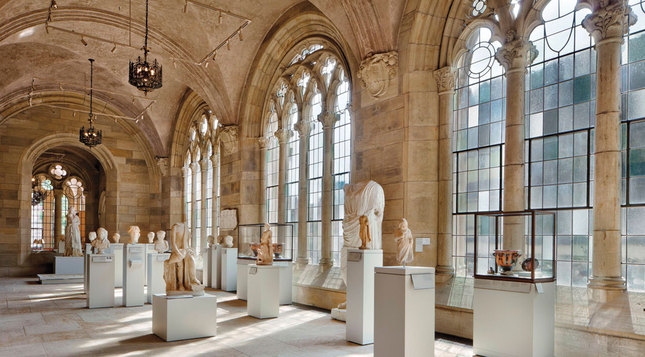
Elizabeth Felicella
The gallery’s collection of ancient art has returned to the light-filled sculpture hall of the Old Art Gallery (above), a space that for many years contained only the site-specific sculpture Stacks by Richard Serra ’64MFA. (Stacks was moved to a restored sunken courtyard next to York Street in 2006.) In the background behind a leaded glass window is one of many new classrooms in the gallery where objects can be brought in for study by visiting classes. Also adjacent to the sculpture hall is a new home for Yale’s collection of 100,000 coins and medals, many of which are on view in other galleries.
View full image

Elizabeth Felicella
The gallery’s collection of ancient art has returned to the light-filled sculpture hall of the Old Art Gallery (above), a space that for many years contained only the site-specific sculpture Stacks by Richard Serra ’64MFA. (Stacks was moved to a restored sunken courtyard next to York Street in 2006.) In the background behind a leaded glass window is one of many new classrooms in the gallery where objects can be brought in for study by visiting classes. Also adjacent to the sculpture hall is a new home for Yale’s collection of 100,000 coins and medals, many of which are on view in other galleries.
View full image
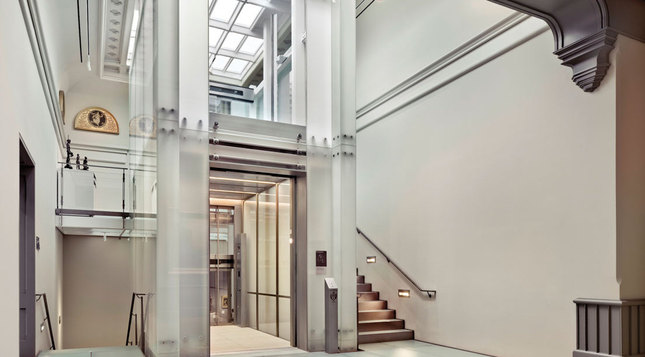
Elizabeth Felicella
A new glass elevator was built in Street Hall in order to make the building accessible to people who can’t climb stairs. The floors of Street Hall and the Old Art Gallery do not align, so the elevator stops at several floor levels between the two buildings.
View full image

Elizabeth Felicella
A new glass elevator was built in Street Hall in order to make the building accessible to people who can’t climb stairs. The floors of Street Hall and the Old Art Gallery do not align, so the elevator stops at several floor levels between the two buildings.
View full image
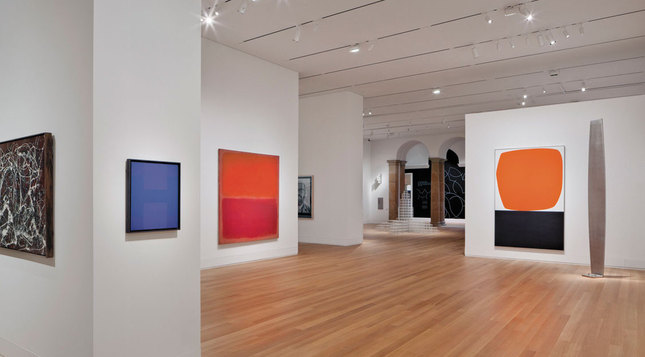
Elizabeth Felicella
Part of the Old Art Gallery that used to be devoted to American decorative arts has been recast as a gallery for modern and contemporary art, including works by Mark Rothko ’25, Chuck Close ’64MFA, and Ellsworth Kelly. In the background behind the columned archways is one of four Sol Lewitt wall drawings in the gallery.
View full image

Elizabeth Felicella
Part of the Old Art Gallery that used to be devoted to American decorative arts has been recast as a gallery for modern and contemporary art, including works by Mark Rothko ’25, Chuck Close ’64MFA, and Ellsworth Kelly. In the background behind the columned archways is one of four Sol Lewitt wall drawings in the gallery.
View full image
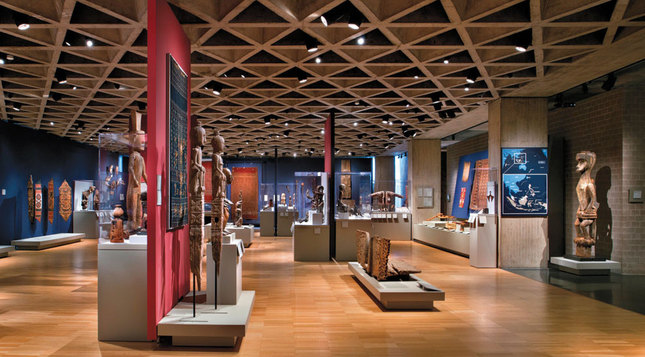
Elizabeth Felicella
The expansion of gallery space made room for some recently acquired collections. On the second floor of the gallery’s Louis Kahn building is a space devoted to Indo-Pacific art, much of it a promised gift from collector Thomas Jaffe ’71.
View full image

Elizabeth Felicella
The expansion of gallery space made room for some recently acquired collections. On the second floor of the gallery’s Louis Kahn building is a space devoted to Indo-Pacific art, much of it a promised gift from collector Thomas Jaffe ’71.
View full image
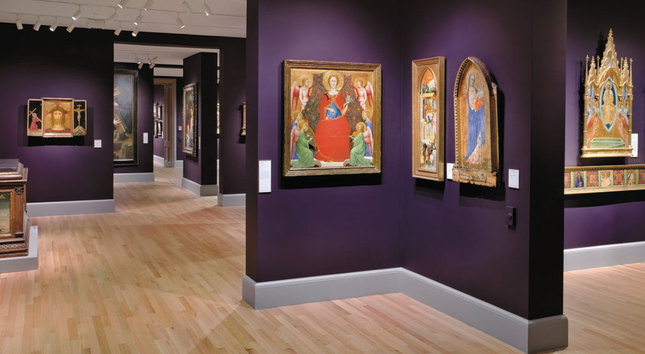
Elizabeth Felicella
Throughout the galleries, wall colors were chosen by curators to complement their collections. The vivid colors of Yale’s noted collection of early Italian art, on the second floor of the Old Art Gallery, are shown off by dark blue walls.
View full image

Elizabeth Felicella
Throughout the galleries, wall colors were chosen by curators to complement their collections. The vivid colors of Yale’s noted collection of early Italian art, on the second floor of the Old Art Gallery, are shown off by dark blue walls.
View full image
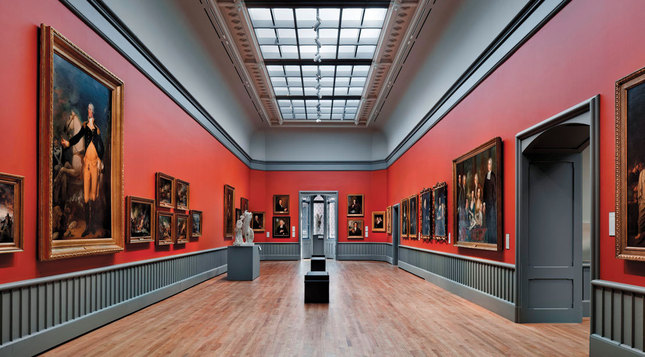
Elizabeth Felicella
Among the biggest surprises in the renovation is the reemergence of Street Hall, which was once home to both the art gallery and the School of Art. The building’s generous gallery spaces had been carved up and its rich details had been hidden over the years. A restored gallery on the second floor of Street is home to American sculpture and paintings, including the John Trumbull paintings of the American Revolution that formed the core of the gallery’s collection when Trumbull sold them to Yale in 1832.
View full image

Elizabeth Felicella
Among the biggest surprises in the renovation is the reemergence of Street Hall, which was once home to both the art gallery and the School of Art. The building’s generous gallery spaces had been carved up and its rich details had been hidden over the years. A restored gallery on the second floor of Street is home to American sculpture and paintings, including the John Trumbull paintings of the American Revolution that formed the core of the gallery’s collection when Trumbull sold them to Yale in 1832.
View full image
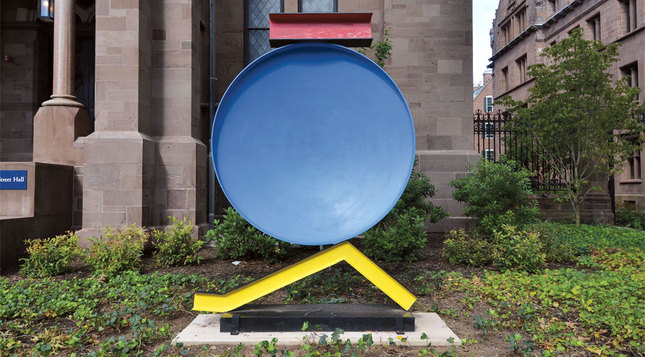
Mark Zurolo '01MFA
The gallery reclaimed a forgotten corner of the Old Campus outside Street Hall, landscaping it and installing outdoor sculptures from its collection, including David Smith’s Bec-Dida Day (above).
View full image

Mark Zurolo '01MFA
The gallery reclaimed a forgotten corner of the Old Campus outside Street Hall, landscaping it and installing outdoor sculptures from its collection, including David Smith’s Bec-Dida Day (above).
View full image
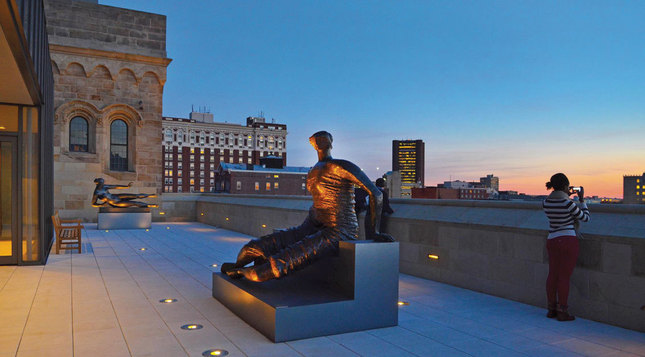
Michael Marsland
Outside a new gallery for temporary exhibitions added to the top of the Old Art Gallery, a rooftop sculpture terrace includes works by Henry Moore (foreground) and Aristide Maillol (background).
View full image

Michael Marsland
Outside a new gallery for temporary exhibitions added to the top of the Old Art Gallery, a rooftop sculpture terrace includes works by Henry Moore (foreground) and Aristide Maillol (background).
View full image

Christopher Gardner
The three buildings that now house the gallery cover a block and a half of Chapel Street (above). Street Hall (1866), the oldest of the buildings, is at right; the Old Art Gallery (1928) is in the center, and the 1953 addition by Louis Kahn is at left. In addition to exhibit space, Street Hall now includes, on its ground floor, a space devoted to educational programs.
View full image

Christopher Gardner
The three buildings that now house the gallery cover a block and a half of Chapel Street (above). Street Hall (1866), the oldest of the buildings, is at right; the Old Art Gallery (1928) is in the center, and the 1953 addition by Louis Kahn is at left. In addition to exhibit space, Street Hall now includes, on its ground floor, a space devoted to educational programs.
View full image
In a time of tightened belts and fiscal cliffs, the most striking thing about the new and improved Yale University Art Gallery is its sense of abundance. It’s more art than you’ve ever seen on display at Yale, more than 4,000 works stretched across three adjoining buildings that themselves cover a century of American architectural history. The gallery’s collections have always been broad, with works spanning from ancient Greece to contemporary New York, but now they are deep, too, with 50 percent more exhibition space than before the renovation.
In December, the gallery completed a ten-year, $135 million renovation and expansion with the unveiling of the renovated Old Art Gallery building (built in 1928) and the reclaimed Street Hall (1866), which was once the home of the gallery and the School of Art but which had been occupied by the history of art department for several decades. While the overhaul of Louis Kahn’s 1953 addition to the gallery in 2006 was a revelation, with the building’s open plan and walls of glass restored to their original splendor, these newest renovations are a more dramatic change to the gallery’s character, allowing a remarkable new diversity of spaces for the display of the varied collection. So large contemporary paintings are hung in high-ceilinged, white-walled galleries, while American paintings and decorative arts of the nineteenth century are seen in the genteel, wainscoted galleries of Street Hall.
It wasn’t the easiest way to expand. Many museums looking for extra space might have added a new building instead of dealing with the myriad safety, structural, and accessibility issues involved in bringing the three buildings up to date. None of the buildings had ever had a major renovation, says director Jock Reynolds, so “we were looking at a total of 280 years of deferred maintenance.”
But Reynolds says the buildings were artworks themselves that the gallery wanted to preserve. “The buildings did present a lot of challenges, but we’d have been crazy not to want to work with them.”
Besides restoring the buildings to something like their original condition—something that, in the case of Street Hall, no living person had ever seen before—the project’s architects (Ennead Architects of New York) found new exhibit space by filling in a previously empty tower in the Old Art Gallery and putting a new gallery and outdoor sculpture terrace on the roof. Reynolds calls the resulting experience “a three-course meal with a nightcap at the top.”
What’s even more impressive about the ambitious project is that it continued with barely a hiccup after the economy collapsed and Yale’s endowment took a $6 billion hit in 2008. At that point, all unfunded building projects had to be completed strictly through gift funding. “To have kept the project going during a recession, when other projects were in a holding pattern, says something about the university, but it says more about Jock Reynolds,” provost and president-elect Peter Salovey ’86PhD told reporters at a press preview in December.
One source of revenue that wasn’t considered was an admission charge. As it has been for decades, admission to the gallery and to any special exhibitions within it is free to the public—abundance for all.
 loading
loading